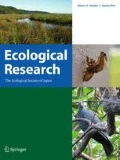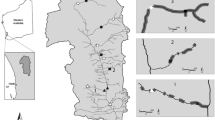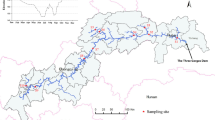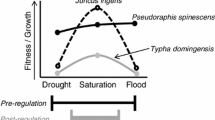Abstract
Hydrologic modifications to rivers caused by anthropogenic activity have major impacts on riparian ecosystems. Alterations to the hydrologic regime and their interactions with natural environmental parameters exert selective pressures on riparian vegetation, resulting in adaptations to specific flow attributes. However, few studies have attempted to detect these effects under multiple hydrologic conditions, especially for rivers in semi-dry and semi-humid regions. Using the “space-for-time substitution” method, we investigated the effects of hydrologic modifications to the riparian plant community along the Yongding River of northern China, by comparing community structure metrics (diversity, plant moisture affinity group, and lifespan) and a function metric (biomass) under three streamflows (perennial, seasonal and dried-up). Among these streamflows, seasonal flow reaches had the greatest plant diversity. Responses of plant moisture group and lifespan were inconsistent in different hydrologic stages, although they varied significantly (P < 0.01). Annuals and biennials greatly increased from perennial to seasonal streamflow (~59 %), while perennials decreased (~41 %). However, from seasonal to dried-up flow, the percentage of mesics and xerics increased by 12.8 and 11.8 %, respectively, while hydrics decreased dramatically (by 24.6 %). Perennial flow had significantly greater aboveground biomass (P < 0.05) than the other two flows. Hydrologic conditions and their related soil nutrients were the main driving factors of community structure and function, which explained 21.0 and 18.0 % of variation, respectively. These findings reveal the response process of the riparian plant community during hydrologic modification from perennial to dried-up streamflow.



Similar content being viewed by others
References
Ali M (2000) Predictors of plant diversity in a hyperarid desert wadi ecosystem. J Arid Env 45:215–230. doi:10.1006/jare.2000.0631
An S, Cheng X, Sun S, Wang Y, Li J (2003) Composition change and vegetation degradation of riparian forests in the Altai Plain, NW China. Plant Ecol 164:75–84. doi:10.1023/A:1021225204808
Araya YN, Gowing DJ, Dise N (2013) Does soil nitrogen availability mediate the response of grassland composition to water regime? J Veg Sci 24:506–517. doi:10.1111/j.1654-1103.2012.01481.x
Baldwin DS, Mitchell AM (2000) The effects of drying and re-flooding on the sediment and soil nutrient dynamics of lowland river-floodplain systems: a synthesis. Regul Rivers Res Manag 16:457–467. doi:10.1002/1099-1646(200009/10)16:5<457:AID-RRR597>3.0.CO;2-B
Berlow EL, Brose U, Martinez ND (2008) The “Goldilocks factor” in food webs. Proc Natl Acad Sci USA 105:4079–4080. doi:10.1073/pnas.0800967105
Bren LJ (1992) Tree invasion of an intermittent wetland in relation to changes in the flooding frequency of the River Murray, Australia. Aust Ecol 17:395–408. doi:10.1111/j.1442-9993.1992.tb00822.x
Breshears DD, Cobb NS, Rich PM et al (2005) Regional vegetation die-off in response to global-change-type drought. Proc Natl Acad Sci USA 102:15144–15148. doi:10.1073/pnas.0505734102
Capon SJ (2003) Plant community responses to wetting and drying in a large arid floodplain. River Res Appl 19:509–520. doi:10.1002/rra.730
Causin HF, Wulff RD (2003) Changes in the responses to light quality during ontogeny in Chenopodium album. Can J Bot 81:152–163. doi:10.1139/b03-012
Changming L, Jingjie Y, Kendy E (2001) Groundwater exploitation and its impact on the environment in the North China plain. Water Int 26:265–272. doi:10.1080/02508060108686913
Chao A, Chazdon RL, Colwell RK, Shen TJ (2005) A new statistical approach for assessing similarity of species composition with incidence and abundance data. Ecol Lett 8:148–159. doi:10.1111/j.1461-0248.2004.00707.x
Colwell RK (2013) EstimateS: statistical estimation of species richness and shared species from samples. Version 9. http://purl.oclc.org/estimates
Debinski DM, Wickham H, Kindsher K, Caruthers JC, Germino M (2010) Montane meadow change during drought varies with background hydrologic regime and plant functional group. Ecol 91:1672–1681. doi:10.1890/09-0567.1
Development Core Team R (2013) R: A language and environment for statistical computing. R Foundation for Statistical Computing, Vienna
Dwire KA, Kauffman JB, Brookshire ENJ, Baham JE (2004) Plant biomass and species composition along an environmental gradient in montane riparian meadows. Oecologia 139:309–317. doi:10.1007/s00442-004-1498-2
Elmore AJ, Mustard JF, Manning SJ (2003) Regional patterns of plant community response to changes in water: owens Valley, California. Ecol Appl 13:443–460. doi:10.1890/1051-0761(2003)013[0443:RPOPCR]2.0.CO;2
Feld CK, Hering D (2007) Community structure or function: effects of environmental stress on benthic macroinvertebrates at different spatial scales. Freshw Biol 52:1380–1399. doi:10.1111/j.1365-2427.2007.01749.x
Fossati J (1999) Water as resource and disturbance for wadi vegetation in a hyperarid area (Wadi Sannur, Eastern Desert, Egypt). J Arid Env 43:63–77. doi:10.1006/jare.1999.0526
Gasith A, Resh VH (1999) Streams in mediterranean climate regions: abiotic influences and biotic responses to predictable seasonal events. Annu Rev Ecol Syst 30:51–81. doi:10.1146/annurev.ecolsys.30.1.51
Grime JP (1979) Plant strategies and vegetation processes. Wiley, New York
Grime JP, Hodgson JG, Hunt R (1988) Comparative plant ecology: a functional approach to common British species. Unwyn Hyman, London
He S, Xing Q, Yin Z (1993) Beijing Flora, 3rd edn. Beijing Publishing House, Beijing (in Chinese)
Hill AR (1996) Nitrate removal in stream riparian zones. J Env Qual 25:743. doi:10.2134/jeq1996.00472425002500040014x
Huang JZ, Shrestha A, Tollenaar M, Deen W, Rahimian H, Swanton CJ (2000) Effects of photoperiod on the phenological development of redroot pigweed (Amaranthus retroflexus L.). Can J Plant Sci 80:929–938. doi:10.4141/P99-134
Hughes FMR (1997) Floodplain biogeomorphology. Prog Phys Geogr 21:501–529. doi:10.1177/030913339702100402
Jansson R, Zinko U, Merritt DM, Nilsson C (2005) Hydrochory increases riparian plant species richness: a comparison between a free-flowing and a regulated river. J Ecol 93:1094–1103. doi:10.1111/j.1365-2745.2005.01057.x
Katz GL, Stromberg JC, Denslow MW (2009) Streamside herbaceous vegetation response to hydrologic restoration on the San Pedro River, Arizona. Ecohydrology 2:213–225. doi:10.1002/eco.62
Katz GL, Denslow MW, Stromberg JC (2012) The Goldilocks effect: intermittent streams sustain more plant species than those with perennial or ephemeral flow. Freshw Biol 57:467–480. doi:10.1111/j.1365-2427.2011.02714.x
Kingsford RT, Thomas RF (1995) The Macquarie Marshes in Arid Australia and their waterbirds: a 50-year history of decline. Env Manag 19:867–878. doi:10.1007/BF02471938
Klute A (1986) Methods of soil analysis. Part 1. Physical and mineralogical methods. ASA and SSSA, Madison, WI
Lake PS (2003) Ecological effects of perturbation by drought in flowing waters. Freshw Biol 48:1161–1172. doi:10.1046/j.1365-2427.2003.01086.x
Larned ST, Datry T, Arscott DB, Tockner K (2010) Emerging concepts in temporary-river ecology. Freshw Biol 55:717–738. doi:10.1111/j.1365-2427.2009.02322.x
Legendre P, Gallagher E (2001) Ecologically meaningful transformations for ordination of species data. Oecologia 129:271–280. doi:10.1007/s004420100716
Leigh C, Sheldon F, Kingsford RT, Arthington AH (2010) Sequential floods drive “booms” and wetland persistence in dryland rivers: a synthesis. Mar Freshw Res 61:896. doi:10.1071/MF10106
Lite S, Bagstad K, Stromberg J (2005) Riparian plant species richness along lateral and longitudinal gradients of water stress and flood disturbance, San Pedro River, Arizona, USA. J Arid Env 63:785–813. doi:10.1016/j.jaridenv.2005.03.026
Lytle DA, Poff NL (2004) Adaptation to natural flow regimes. Trends Ecol Evol 19:94–100. doi:10.1016/j.tree.2003.10.002
McIntyre S, Lavorel S, Tremont RM (1995) Plant life-history attributes: their relationship to disturbance response in herbaceous vegetation. J Ecol 83:31. doi:10.2307/2261148
Minggagud H, Yang J (2013) Wetland plant species diversity in sandy land of a semi-arid inland region of China. Plant Biosyst 147:25–32. doi:10.1080/11263504.2012.737865
Naiman R (1997) The ecology of interfaces: riparian zones. Annu Rev Ecol Syst. pp 621–658
Nilsson C, Svedmark M (2002) Basic principles and ecological consequences of changing water regimes: riparian plant communities. Env Manag 30:468–480. doi:10.1007/s00267-002-2735-2
Pettit NE, Froend RH, Davies PM (2001) Identifying the natural flow regime and the relationship with riparian vegetation for two contrasting western Australian rivers. Regul Rivers Res Manag 17:201–215. doi:10.1002/rrr.624
Poff NL, Allan JD, Bain MB, Karr JR, Prestegaard KL, Richter BD, Sparks RE, Stromberg JC (1997) The natural flow regime. Bioscience 47:769–784. doi:10.2307/1313099
Porporato A, Laio F, Ridolfi L, Rodriguez-Iturbe I (2001) Plants in water-controlled ecosystems: active role in hydrologic processes and response to water stress: III. Vegetation water stress. Adv Water Resour 24:725–744. doi:10.1016/S0309-1708(01)00006-9
Rajcan I, AghaAlikhani M, Swanton CJ, Tollenaar M (2002) Development of redroot pigweed is influenced by light spectral quality and quantity. Crop Sci 42:1930. doi:10.2135/cropsci2002.1930
Ren L, Wang M, Li C, Zhang W (2002) Impacts of human activity on river runoff in the northern area of China. J Hydrol 261:204–217. doi:10.1016/S0022-1694(02)00008-2
Richter BD, Braun DP, Mendelson MA, Master LL (1997) Threats to Imperiled freshwater fauna. Amenazas a la Fauna Dulceacuicola en Riesgo. Conserv Biol 11:1081–1093. doi:10.1046/j.1523-1739.1997.96236.x
Rupp DE, Larned ST, Arscott DB, Schmidt J (2008) Reconstruction of a daily flow record along a hydrologically complex alluvial river. J Hydrol 359:88–104. doi:10.1016/j.jhydrol.2008.06.019
Salinas MJ, Casas JJ (2007) Riparian vegetation of two semi-arid mediterranean rivers: basin-scale responses of woody and herbaceous plants to environmental gradients. Wetl 27:831–845. doi:10.1672/0277-5212(2007)27[831:RVOTSM]2.0.CO;2
Schimper AFW (1898) Pflanzen-geographie auf physiologischer Grundlage. G. Fischer, Jena
Shafroth P, Stromberg J (2002) Riparian vegetation response to altered disturbance and stress regimes. Ecol Appl 12:107–123. doi:10.2307/3061140
Steward AL, von Schiller D, Tockner K, Marshall JC, Bunn SE (2012) When the river runs dry: human and ecological values of dry riverbeds. Front Ecol Env 10:202–209. doi:10.1890/110136
Stromberg JC, Patten DT (1990) Riparian vegetation instream flow requirements: a case study from a diverted stream in the Eastern Sierra Nevada, California, USA. Environ Manag 14:185–194. doi:10.1007/BF02394035
Stromberg JC, Bagstad KJ, Leenhouts JM, Lite SJ, Makings E (2005) Effects of stream flow intermittency on riparian vegetation of a semiarid region river (San Pedro River, Arizona). River Res Appl 21:925–938. doi:10.1002/rra.858
Stromberg JC, Boudell JA, Hazelton AF (2008) Differences in seed mass between hydric and xeric plants influence seed bank dynamics in a dryland riparian ecosystem. Funct Ecol 22:205–212. doi:10.1111/j.1365-2435.2007.01375.x
Stromberg JC, Hazelton AF, White MS (2009a) Plant species richness in ephemeral and perennial reaches of a dryland river. Biodivers Conserv 18:663–677. doi:10.1007/s10531-008-9532-z
Stromberg JC, Hazelton AF, White MS et al (2009b) Ephemeral wetlands along a spatially intermittent river: temporal patterns of vegetation development. Wetl 29:330–342. doi:10.1672/08-124.1
Tabacchi E, Planty-Tabacchi A, Salinas MJ, Décamps H (1996) Landscape structure and diversity in riparian plant communities: a longitudinal comparative study. Regul Rivers Res Manag 12:367–390. doi:10.1002/(SICI)1099-1646(199607)12:4/5<367:AID-RRR424>3.3.CO;2-O
Tian YC, Zhou YM, Wu BF, Zhou WF (2008) Risk assessment of water soil erosion in upper basin of Miyun Reservoir, Beijing, China. Env Geol 57:937–942. doi:10.1007/s00254-008-1376-z
Walker KF, Sheldon F, Puckridge JT (1995) A perspective on dryland river ecosystems. Regul Rivers Res Manag 11:85–104. doi:10.1002/rrr.3450110108
Wang C, Cao G, Wang Q, Shi JJ, Du YG, You RJ (2007) Characteristics of artificial grassland plant communities with different establishment duration and their relationships with soil properties in the source region of Three Rivers in China. Chin J Appl Ecol 18:2426–2431
Wang W, Tang XQ, Huang SL, Zhang SH, Lin C, Liu DW, Che HJ, Yang Q, Scholz M (2010) Ecological restoration of polluted plain rivers within the Haihe River basin in China. Water Air Soil Pollut 211:341–357. doi:10.1007/s11270-009-0304-5
Wang G, Li H, An M, Ni J, Ji SJ, Wang J (2011) A regional-scale consideration of the effects of species richness on above-ground biomass in temperate natural grasslands of China. J Veg Sci 22:414–424. doi:10.1111/j.1654-1103.2011.01279.x
Ward JV (1998) Riverine landscapes: biodiversity patterns, disturbance regimes, and aquatic conservation. Biol Conserv 83:269–278. doi:10.1016/S0006-3207(97)00083-9
Warming E (1909) Saxifragaceae. 1. Morphology and biology. Meddelelser Grønl 36:169–236
With KA, Crist TO (1995) Critical thresholds in species’ responses to landscape structure. Ecol 76:2446–2459. doi:10.2307/2265819
Wu Z, Raven PH, Hong D (1994) Flora of China. Science Press, Beijing and Missouri Botanical Garden Press, St. Louis, Missouri
Wulff R, Causin HF, Benitez O, Bacalini PA (1999) Intraspecific variability and maternal effects in the response to nutrient addition in Chenopodium album. Can J Bot 77:1150–1158. doi:10.1139/b99-124
Young-Mathews A, Culman SW, Sánchez-Moreno S, Toby O’Geen A, Ferris H, Hollander AD, LE Jackson (2010) Plant-soil biodiversity relationships and nutrient retention in agricultural riparian zones of the Sacramento Valley, California. Agrofor Syst 80:41–60. doi:10.1007/s10457-010-9332-9
Yu M, Wei YS, Liu JG, Liu PB, Zhang ZM, Wei W, Wang YW, Zhong J, Yang Y, Xiao QC, Yu DW, Zheng X (2011) Impact of socioeconomic development on water resource and water environment of Yongding River in Beijing. Acta Sci Circumstantiae 31:1817–1825
Zelnik I, Čarni A (2008) Distribution of plant communities, ecological strategy types and diversity along a moisture gradient. Community Ecol 9:1–9. doi:10.1556/ComEc.9.2008.1.1
Zhang J, Döll P (2008) Assessment of ecologically relevant hydrological change in China due to water use and reservoirs. Adv Geosci 18:25–30. doi:10.5194/adgeo-18-25-2008
Zhang Z, Shen Z, Xue Y et al (2000) Evolution of Groundwater Environment in North China Plain, 1st edn. Geological Publishing House, Beijing
Acknowledgments
We thank the people who helped with fieldwork and provided helpful suggestions on the experimental design and manuscript improvement, in particular Hua Zheng, Zhiming Zhang, Yushun Chen, Yun Wang, and Juanjuan Zhao. This study was supported by the Special Fund of Forestry Industrial Research for Public Welfare of China (201204201) and the National Program on Key Basic Research Project (2006CB403402). MG was funded by the EU FP7 project BioFresh (http://www.freshwaterbiodiversity.eu, contract no. 226874). We also thank the anonymous reviewers for their useful suggestions.
Author information
Authors and Affiliations
Corresponding author
Electronic supplementary material
Below is the link to the electronic supplementary material.
About this article
Cite this article
Xiu, C., Gerisch, M., Ilg, C. et al. Effects of hydrologic modifications to riparian plant communities in a large river system in northern China. Ecol Res 30, 461–469 (2015). https://doi.org/10.1007/s11284-015-1243-9
Received:
Accepted:
Published:
Issue Date:
DOI: https://doi.org/10.1007/s11284-015-1243-9




